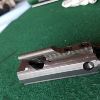Sammael94
Member


Hey all, my AR is still not working. Today I went to my LGS and found they were having a going out of business sale, decided to get the above pictured fore end cap just on the off chance that my gas block was misaligned with the gas port in the barrel and that's why my gun wasn't getting enough gas to operate the action.
Turns out that wasn't the issue (as I'm sure you guessed), but it did bring to light a potential issue with the block its self bleeding gasses completely out of the firearm. The pictured above were taken after firing 9 rounds of IMI surplus ammo during the course of testing my admittedly far-fetched solution to my problem. As you can see, the cap is covered in carbon, and so was the barrel under the gas block when i disassembled this evening. Is all the gas leaking out of my gas block? Is that what's causing my cycling problems? Is my solution to simply get a higher quality gas block? Any input is appreciated. I'm tired of my super cool home built AR not working.
Thanks in advance for your time and help.



